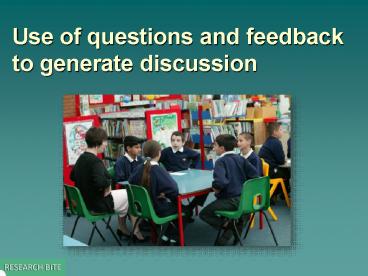Use of questions and feedback to generate discussion - PowerPoint PPT Presentation
1 / 14
Title:
Use of questions and feedback to generate discussion
Description:
Title: Effective Classroom Interaction: use of questions and feedback to generate discussion Author: Colin Isham Last modified by: victoria Document presentation format – PowerPoint PPT presentation
Number of Views:99
Avg rating:3.0/5.0
Title: Use of questions and feedback to generate discussion
1
Use of questions and feedback to generate
discussion
2
The study in context
- This study looked at how interactive
classrooms operate and the strategies teachers
employ to support pupils shared and individual
learning e.g. through the use of reasoning
skills, exploration and discussion.
3
Feedback strategies teachers used to create
interactive classrooms
- In primary English and maths lessons teachers
- built on pupils responses
- encouraged children to feedback to each other
- used pupils input to shape lessons
4
Techniques for building on pupils responses to
establish dialogue
- Teachers used prompts such as oh, ooh, ah,
gave opinions and drew on personal experiences,
e.g. - Pupil Ehm, its a guitar with laser stringsits
for teenagers that actually know how to play the
guitar - Teacher Ah, now I have to say I think thats
going to appeal to people who play guitar. I know
my sister plays the guitar, it drives her mad
every time the strings break
5
Encouraging children to feedback to each other
- Teachers invited pupils to respond to each
others answers for example - - Teacher Ok ready three, two, one, show me,
brilliant, pupils name read it out for me
please. - - Pupil Fourfour hundred and twenty thousand.
- - Teacher Pupil thinks shes got four hundred
and twenty thousand, anybody want to disagree?
6
Drawing on pupils input to shape lessons
- Teachers actively engaged pupils in developing
the lesson for example - - Pupil You could rotate it a shape and then
that would fit. - - Teacher Ooh rotate it then
- - Pupil Ok, ehm right laughs... pause as pupil
tries to draw rotated shape - - Teacher It is a bit tricky isnt it? Can you
on the whiteboards in front of you try and rotate
the shape? teacher opens the task to the whole
class
7
How did teachers use open questions to stimulate
discussion?
- Teachers used open questions which invited
multiple answers and encouraged children to
discuss and negotiate a final answer for
example - Teacher Ok what things are important in
instructions? If we were going to write a
checklist for when I do this with my class next
year, what things would you say to them? What
would have to be in your instructions?
8
How did teachers use closed questions to
stimulate interaction?
- Effective teachers used closed questions to build
on pupils thinking and draw in others
responses, e.g. the teacher is explaining that
multiplying by 100 is the same as multiplying by
10 and then 10 again, a pupil asked the following
commented - - Pupil You know when you times it by 20, you do
two 10s. - Teacher No, think carefully its not two 10s is
it, its 1 times 10 and then you? - - Pupil Double it.
- Teacher Do you see where you went wrong there?
9
Who were the children in the study?
- The researchers observed and analysed teacher-
pupil interaction in 213 primary literacy and
numeracy lessons (114 Year 5 literacy and
numeracy lessons in 2003, and 99 Year 5 and 6
lessons in 2004)
10
How was the information gathered?
- The researchers observed and analysed classroom
interactions over a two year period - They used hand held computers and video to record
lessons - They selected five English and five maths lessons
that showed the most interaction to investigate
teacher behaviours in more detail
11
How can teachers use this evidence?
- The study found that teachers played a key part
in creating and maintaining effective discussion.
You could reflect on how you use dialogue in your
lessons. Can you think of a lesson where your
pupils had a good discussion and learning took
place? - What role did you play in helping those
discussions? - Are there any particular effective strategies you
used that you would use again?
12
How can school leaders use this evidence?
- The study found that some teachers were effective
in stimulating discussion in their classrooms and
others less so. How effective are staff in your
school in exploiting the potential of interactive
teaching and learning? - Do you have staff members who are effective
promoters of classroom dialogue? - Could you engage them in coaching other staff who
are trying to develop in this area?
13
Follow-up reading
- Study reference Smith, H. Higgins, S. Opening
classroom interaction the importance of feedback
(2006) Cambridge Journal of Education Vol. 36,
No. 4, pp. 485-502 - The GTCs Research of the Month (RoM) website
presents a number of research summaries that
cover relevant fields of interest such as
dialogue and AfL. The RoMs can be found at
http//www.gtce.org.uk/research/romtopics/
14
Feedback
- Did you find this useful?
- What did you like?
- What didnt you like?
- Any feedback on this Research Bite
- would be much appreciated. Please email
- your feedback to
- research.summaries_at_dcsf.gsi.gov.uk










![How to Use Customer Education As a Marketing Tool [Tips & Checklist] PowerPoint PPT Presentation](https://s3.amazonaws.com/images.powershow.com/9857872.th0.jpg?_=20230224083)




















